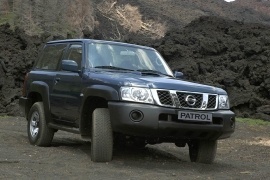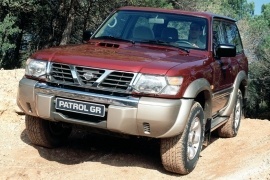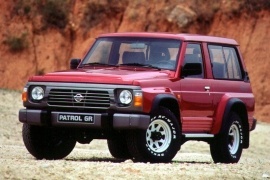
NISSAN Patrol SWB
Generations Timeline, Specs and Pictures

The Patrol regenesis saw a refreshed car with new underpinnings and a completely restyled body.
Slightly larger than previous generation models, the new Patrol was powered by an improved 4-cylinder 3.0 Liter Turbodiesel unit with a power output of 160 hp and 380 Nm of max torque, ensuring great pulling capacity. Live axles haven’t been given yet up with the Patrol sporting an even sturdier suspension system, the same which made it a popular choice, among others, for off-roaders. Equipment levels were also raised, broadening the customer’s range of choices which included the XE, SE and LE trims and their variations.

Nissan introduced the fifth generation of the Patrol in late 1997 as a 1998 model, and it produced it in a short or long-wheelbase configuration, with two or four side doors.
The Patrol’s roots are going back in time until 1951 when the Japanese carmaker built the 4W60 model based on a Willys CJ-3 chassis. Over time, the carmaker learned how to develop the vehicle until it became one of the best 4x4 vehicles in the world.
Nissan designed the Patrol’s fifth generation to look like a civilized vehicle. It was still big, but its rough edges and flat panels were gone. The three-door version (four, actually) was shorter and easier to live with in a city. It was shorter than a compact-sized sedan but wider and definitely taller. Its wide door allowed the passengers to climb aboard, while in the back, Nissan installed two unequal-length, side-hinged doors.
Inside, the cabin offered five seats, but it provided little room for the rear passengers despite the vehicle’s exterior size. Nissan spoiled the front occupants with large, comfortable seats, divided by a tall center console where the carmaker added a storage compartment and a large ashtray. On the center stack, the carmaker installed a standard AC unit and a stereo-cassette player.
The most important part of the Patrol’s success was under the body. Its curved, sturdy chassis provided an excellent platform for serious off-roading. Nissan used live axles both front and rear, with an adjustable stabilizer bar, which, combined with the coil-springs in all corners, increased the suspension travel. The carmaker offered the Patrol a wide engine range, both gasoline and diesel, depending on the countries and areas. The high and low transfer case was fitted as standard on the entire range.

Shorter and lighter than the LWB, the short-wheelbase Patrol was one of the perfect candidates for tough off-road conditions management.
Powered by the same range of engines as the LWB, the 3-door hardtop delivered 92 hp with the normally aspirated 2.8 Diesel unit and 116 hp with the turbocharged versions. Apart from being a tough-built vehicle, the Patrol was a conservatively smart vehicle thanks to Nissan’s choice of old-school suspension. While most of the competitors had switched to independent suspension, the Patrol was still holding tight to its live axles which allowed for easy maintenance and ground clearance increase.























































